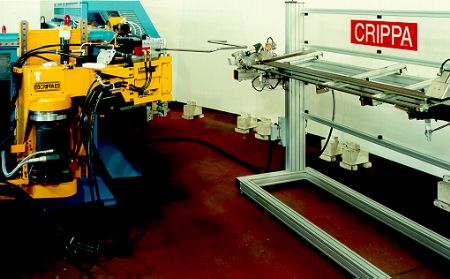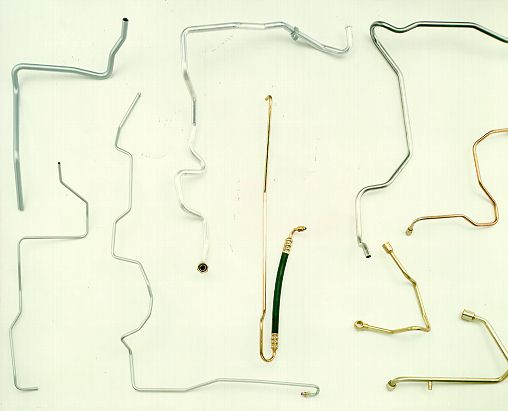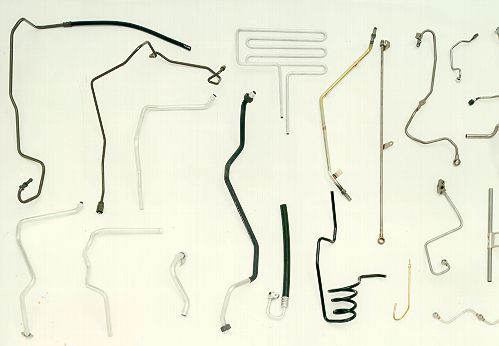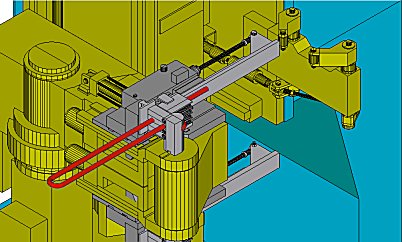Air conditioning in the car industry and metal tube bending
by Antonio Crippa
Crippa, SPA, Italy
Air conditioning in the car industry is a sector, which has been steadily growing in importance over recent months, also thanks to tendencies and trends in international safety standards.
In fact it has been proved that there is a correlation between driver's safety and driving comfort of the car, hence air conditioning on board the car (and heavy vehicles) is no longer considered a luxury option as up to a short time ago; rather it now falls into the category of safety devices either already equipping cars, or to be which will be finding increasing application in cars, including medium displacement types.
After this introduction, we shall now see how car manufactures and their subcontractors producing the air conditioning systems and tube fittings are adapting themselves.
It is well known that air conditioners, including the most sophisticated ones, draw in air from the outside, whereupon they "process" the air by adjusting it to a suitable degree of humidity and temperature. The air is then distributed in a "clean" state to the internal environment requiring air conditioning.
Unlike the case of household or industrial air conditioning, in the automobile field there is the problem of limited physical space as the tubes through which the fluids circulate must be housed in the spaces existing between the engine and carbody according to precise logistic and path layouts, which are obviously decided during the car design stage.
The current tendency of car manufacturers is that of adopting increasingly more powerful and larger engines (depending on the options provided), located in engine compartments which must keep their volume unchanged. As a result, the free internal space which can be used for housing the tubes and their connection to the air conditioning system, suction pump, inlets and outlets, is becoming less and less; such factors often imply winding paths, with increasingly more complex geometric configurations of the bent tubes.
For a clearer characterization of the types of tubes used, we can say that the material of construction is usually aluminium. Tube diameter varies from 8 to 20 mm with wall thickness normally less than 1 millimetre. Tube length is almost always less than one and a half metres, while the number of bends ranges from 3-4 to 12-13. Production lots for each tube bending machine set-up normally comprise between 100 and 1000 pieces.
The complex geometric configurations to be obtained as well as the dimensions and chemical-physical properties of the materials often impose major constraints on the tube bending processes in car air conditioning. Hence they require machines and systems with special characteristics in terms of quality, performance and flexibility, as well as tooling on board the machine suitable for the complexity of the processes.
Using terminology familiar to experts in the field, we are dealing with ever narrower bending radii, and ratio between bending radius and tube diameter much less than 2.5, under which limit the tube must be worked with "mandrel" inside it in order to safeguard the quality of the finished component. There are also different bending radii, or else very reduced straight lengths between bends or even none at all. This normally implies manual secondary positioning operations on the same tube for tool changing purposes unless a Crippa CA520 system is available. Such system works with several bending planes differing from each other, therefore it allows fully automatic bending of any geometric configuration. The advantage of avoiding secondary positioning of the tube is also ensured by machines incorporating the facility of double bending direction (left- and right-hand). And yet again, even if the list of new requirements could continue, we have systems featuring "on-line" quality control which allow practically immediate corrective actions on variations and "deviations" in the production process exceeding the preset tolerances.

CA520 bending machine with automatic loading.
|
As regards the production cycle, the current tendency regards transformation cells which, starting from the tubes cut-to-size, perform various types of tube working operations, upstream and downstream to bending; such operations also concern the tube ends. Complementary tube working operations include swaging, end-forming, gauging, inserting of nuts or washers, etc. (see photo of the bent tubes).

Automotive tubes bent by CA520 bender
|
All these factors encourage working with an ever higher degree of automation and consequent less and less operator supervision.
Last, but not least, there is the problem of automatic feeding of the tube bending system through loading and unloading devices. The most costly solution is the robot, while the use of plainer "manipulators" represents an intermediate solution. The ideal solution is that of having of tube bending system also incorporating tube pick-up and unloading through appropriate movements of the bending head.
Up till now we have considered current requirements and tendencies in the car air conditioning sector on the basis of application complexity, the quality of the finished parts, productivity, flexibility, integrability in production cells, quality control, etc.
All those requirements define the identikit of a tube bending machine, model CA520 manufactured by Crippa, which is currently the only one on the market able to fully meet such requirements.
Crippa, in pointing out this supremacy, would like to emphasize that the inspiration behind the design and development of this machine, has been the search for solutions offering levels of excellence absolutely not available on the market.
Among the characteristics for which customers have expressed their appreciation, is the potential for growth and development of this model: in fact the initial design can cater for several enlargements and development phases which will be implemented when the market so demands.
While the CA520 is the most complete and ideal model of tube bending machine in the car or industrial air conditioning sector, it can happen that certain application requirements in the car industry but also in small diameter tubes in general, need machines of different conception, for example, tubes of the power steering, whose diameter does not normally exceed 16 mm. In this case, the CA520 with its capacity up to 20 mm would not be fully exploited. Furthermore many applications, instead of requiring five controlled axes, only need three or four. To meet the widely differing requirements, and to supply the most ideal tube bender for each specific application, the machine series CAx16-CAx25 has been conceived, where "x" indicates the number of controlled axes, 3,4, 5 or more, while 16-25 indicates the maximum tube diameter in mm.
A particularly interesting model of this series is the CA 316-R with three controlled axes for tubes up to 16 mm, which is really ideal for the tubes of the car power steering. The frame of this machine, as laid down in the design, appears "turned over" compared to that of the conventional tube benders. This is to favour its inclusion in highly automated production processes; e.g. in work islands or cells. In fact, thanks to this design feature, the machine can be fed automatically in a considerably easier way and the tube can be submitted just as easily in automatic mode to subsequent tube working operations. Or else, the tube can be deposited on a conveyor belt for automatic unloading and quicker handling of the production process.

Automotive air conditioning tubes
|
Technological progress during recent times has not only involved the machines with their tooling and numerical controls, but has also, although to a less apparent extent, involved the software in its widest meaning. The same methods of approach to customers' problems and their solutions, have undergone considerable development. Complex problems are examined "on paper" with simulations through CAD, while the solutions are discussed and agreed upon beforehand with the users who benefit from a valuable consultancy on how to produce to one's best and how to reduce possibilities of errors and inefficiency in the production facilities.
An example of this is shown in figure below, consisting of a CAD assisted feasibility study which allows discovering on paper that the preset part program cannot be transferred into actual production as the tube, half-way through the work cycle, has a zone of interference with the machine.

CAD assisted feasibility study shows problem situations easily
|
Certain modifications to the bending program parameters on the CNC will allow, after a new feasibility study, working the part without abnormal
conditions or interferences, with clear economic advantages in terms of time and efficiency. Below some other viewa from the CAD assisted feasibility
study:
The validity of the above statements is not only limited to the car air conditioning sector, but also, in more general terms, it extends to a whole wider field of small diameter tubes not exceeding 25 mm. In fact there is no doubt that the intrinsic characteristics of the bent components, the quality of workmanship, accuracy, repeatability, complexity of the geometric shapes, should be combined with high automation of the production processes, in order to achieve the most competitive possible ratio between quality and cost of lots produced. The automobile sector is especially sensitive to such concepts, where the search for quality is increasingly more intense and in which production runs of bent tubes entail millions of parts. Tube bending machines operating in this sector, such as model CA520, stand out for their levels of reliability, ruggedness, versatility and performance unheard of just a few years ago.
However, not without a certain degree of satisfaction, we can state that, despite the impressive targets reached up till now, we have by no means reached the finishing straight. Much remains to be done in this sector and the next announcements, expected within a few months, will surely confirm this.
Crippa SpA
Attn: Antonio Crippa
Via Buonarroti 3, I-22060 Arosio (CO), Italy
Fax: +39 031 762403
WWW. http://www.crippa.it
Email.
|